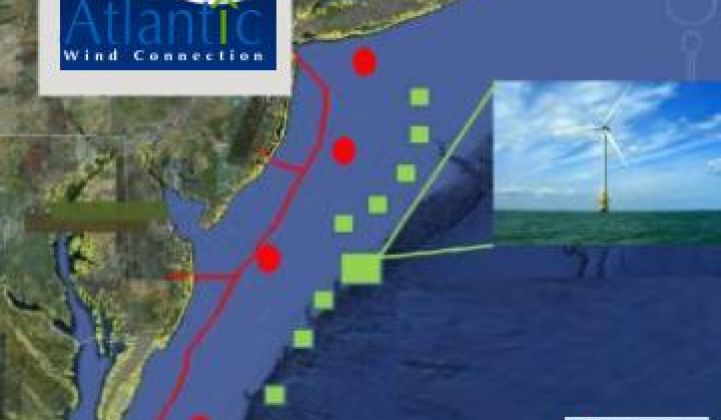In a major step toward lighting up Eastern Seaboard cities with wind-generated electricity, Atlantic Grid Development (AGD) has filed for a right-of-way to build its Atlantic Wind Connection (AWC), an offshore transmission backbone that would streamline ocean wind power delivery.
Watching the AWC unfold is surely what it must have been like watching the interstate highway system or the internet become realities. Something incredible is being born.
“Our project is designed to facilitate large-scale development,” said Markian Melnyk, president of AGD, “by reducing the time it takes for individual wind farm developers to connect to the grid.”
AWC will be a 300-mile, high voltage, direct current transmission line in the seabed beneath federal waters from the northern New Jersey/New York City metropolitan area to Virginia, with nine above-sea platforms along the way. At these hubs, offshore wind farms can plug in and power converters can intermix multiple wind sources, as well as traditional generation sources. Plans now call for seven onshore transmission system interconnections.
“It’s really the perfect area,” Melnyk explained. “You have a large amount of load pretty close to the resource [... and] a broad, gently sloping continental shelf that doesn’t get too deep as you get further out.” In addition, “the energy prices are pretty high, so the subsidy needed to support offshore wind in its early stages is not so great.” Plus, he concluded, the U.S. Department of Energy has designated it “a severely congested area that needs new transmission. But the area is too populated and environmentally sensitive to build on land.”
With the backbone system in place, wind-generated electricity “will be able to get all over the Eastern coastal states and connect to some of the strongest points on the grid,” said Eli Farrah, legal counsel for AWC with Washington law firm Dewey & LeBoeuf. “And it takes the burden off the back of the developers and puts it on the AWC, initially, and then ultimately on the grid and transmission customers.”
With the request of a right-of-way (ROW) from the U.S. Department of Interior’s Bureau of Ocean Energy Management (BOEM), AWD begins the permitting process. When it is granted, manufacturing and construction work on the Outer Continental Shelf can begin.
After the Federal Energy Regulatory Commission (FERC) grants a separate petition from AWD regarding their proposed tariff rate, they will go to PJM Interconnection, the overseeing system operator, to finalize cost details.
“The system is going to cost,” Melnyk said, “But the system also provides benefits. What Brattle found,” he explained, referring to the economic research group, “was that connecting 6,000 megawatts was three billion to five billion dollars and that our system was 4.9 billion to 5.6 billion dollars. But Brattle also found that the benefit of doing it with a backbone system, because it helps keep permitting to scale and drives down the cost of building wind energy, could provide nine billion to fifteen billion dollars' worth of benefits.”
As part of the PJM Interconnection, AWC’s costs will ultimately be carried by ratepayers. Until tariffs are established by FERC and PJM, it will not be clear what the ratepayer costs and benefits will be.
Driving the process are Renewable Energy Standards (RES) in states from Maine to Virginia.
“The need for the line is related to the need to develop renewable energy resources locally,” Melnyk said. He expects FERC, in its soon-to-come final transmission planning ruling to system operators, to “instruct them” to “look at what’s needed to satisfy the renewable energy needs of the area.”
And, added Farrah, “PJM has determined it needs to move forward independently, to revise its planning criteria to account for renewable energy needs.”
The project will progress in five geographic stages, beginning in the New York-New Jersey region where power prices are highest, and ending at the far ends of the line where power is cheapest. All required permits for the first phase are expected to be in place by 2013, allowing construction to begin by 2016. Completion of the entire backbone system, now optimized from earlier designs and capable of carrying as much as 7,000 megawatts, is planned for 2021.
“We have investors -- Google Good Energies and Marubeni -- that are providing the development capital,” Melnyk said. With the right-of-way from BOEM and the approved tariff, they will be assured of revenues “to operate, maintain and pay debts and return on capital. That will support us raising debt and equity financing to actually construct the project.”
The AWC route for which AWD requested the right-of-way was chosen through a rigorous selection process.
“We built an offshore wind cost production model,” Melnyk said. It included wind speeds, bathymetry, seabed conditions, and even foundation cost variables. With it, they “identified areas offshore that would provide energy at the lowest cost.”
They also assimilated environmental information, including where fish habitats are, where fishermen work and where ocean obstacles are. “We used those two pieces of information, energy production information and environmental information,” Melnyk said, “to find those areas that would produce power at the lowest cost but also have the fewest permitting problems.”
The EU is planning to obtain 40 percent of its power from offshore wind by mid-century. Estimates put the potential for Atlantic coast ocean winds even higher, suggesting that the Atlantic Wind Connection, if it succeeds, can do the same thing the interstate highway system and the internet did for the U.S. economy.



